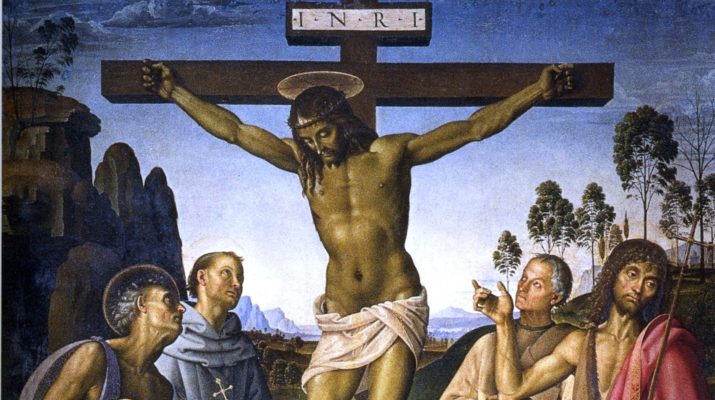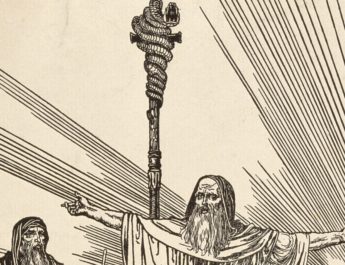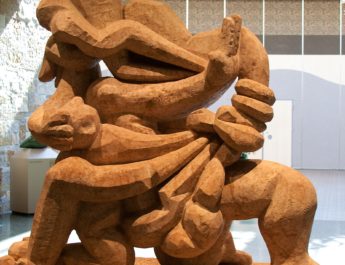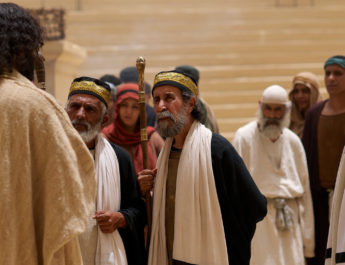John 19:16b-22
Narrative Lectionary 436
16 Then he handed him overA to them to be crucified.B
So they tookC Jesus;D
A “handed…over” = paradidomi. From para (from beside, by) + didomi (give, offer, place, bestow, deliver; give in a literal or figurative sense). This is literally to hand over – hence to deliver, abandon, or betray. It implies a personal involvement.
B “crucified” = stauroo. From stauros (upright stake, cross; literally the horizontal beam of a Roman cross, generally carried by the one convicted to die); from the same as histemi (to stand, cause to stand). This can be to attach someone to a cross or fencing with stakes. In a figurative sense, it could be to destroy, mortify, or subdue passions/selfishness.
C “took” = paralambano. From para (beside, by, in the presence of) + lambano (active acceptance/taking of what is available or what has been offered; emphasizes the choice and action of the individual). This is to receive, take, acknowledge, associate with. It can also mean to take on an office or to learn.
D “Jesus” = Iesous. From Hebrew Yehoshua (Joshua, the Lord is salvation); {from YHVH (proper name of the God of Israel; the self-existent and eternal one); {from havah (to become) or from hayah (to come to pass, become, be)} + yasha (to deliver, defend, help, preserve, rescue; properly, to be open, wide or free, which implies being safe. So, in a causative sense, this is to free someone)}. This is Jesus or Joshua in Greek – the Lord saves or the Lord is salvation.
17 and carryingE the crossF by himself, he went outG to what is calledH
E “carrying” = bastazo. Perhaps from the base of basis (step, hence foot; a pace); from baino (to walk, to go). This is to lift in a literal of figurative sense. It can also mean take up, carry, bear, or remove. Figuratively, it can mean declare, endure, or sustain.
F “cross” = stauros. Related to “crucified” in v16. See note B above.
G “went out” = exerchomai. From ek (from, from out of) + erchomai (to come, go). This is to go out, depart, escape, proceed from, spread news abroad.
H “called” = lego. This is to speak, say, name, call, command. It is generally to convey verbally.
The PlaceI of the Skull,J which in HebrewK is called Golgotha.L
I “Place” = topos. This is a place or region. It is a smaller space that can only hold a limited number of people whereas chora is a larger place. Figuratively it could be an opportunity.
J “Skull” = kranion. 4x in NT. From kara (the head) OR from the base of keras (horn or something horn-shaped; horn in a literal or figurative sense – that which prevails or a symbol of power). This is skull. It’s where we get the word “cranium” from.
K “in Hebrew” = Hebraisti. 7x in NT. From Hebrais (Hebrew language, Aramaic); from Eber (Heber); from Hebrew Eber (the region beyond; Eber, the name of several Israelites including a descendant of Shem); from abar (to pass over, pass through, or pass by; cross over or to alienate; used for transitions). This is Hebrew, perhaps meaning a descendant of Eber. This is in Hebrew or in Aramaic.
L “Golgotha” = Golgotha. 3x in NT. From Aramaic golgolta (skull); from Hebrew gulgolet (skull, head; a census or poll that counts people by head); from galal (to roll in a literal or figurative sense, roll away, roll down, wallow, remove, trust). This is Golgotha, skull. See https://en.wikipedia.org/wiki/Calvary & https://en.wiktionary.org/wiki/%D7%92%D7%95%D7%9C%D7%92%D7%95%D7%9C%D7%AA
18 There they crucified him, and with him twoM others,N one on either side, with Jesus betweenO them.
M “two” = duo. This is two or both.
N “others” = allos. This is other, another. Specifically, it is another of a similar kind or type. There is a different word in Greek that speaks of another as a different kind (heteros).
O “between” = mesos. Perhaps from meta (with among, behind, beyond; implies a change following contact or action). This is middle, among, center, midst.
19 PilateP also had an inscriptionQ writtenR and putS on the cross.
P “Pilate” = Pilatos. From Latin Pilatus (may mean one who has skill with a javelin); perhaps from pilum (javelin) OR perhaps from pileus (a soft cap made of felt that was brimless and was associated with people who were freedmen). This is Pilate. See https://en.wikipedia.org/wiki/Pontius_Pilate
Q “inscription” = titlos. 2x in NT. From Latin titulus (“title, placard, tablet, inscription, epitaph”; probably from Etruscan). This is title, inscription, or notice. See https://en.wiktionary.org/wiki/titulus#Latin
R “written” = grapho. This is to write or describe. It is where the word “graphic” comes from.
S “put” = tithemi. This is to put, place, set, fix, establish in a literal or figurative sense. Properly, it is placing something in a passive or horizontal position.
It read,T “Jesus of Nazareth,U the KingV of the Jews.”W
T “read” = grapho. Same as “written” in v19. See note R above.
U “Nazareth” = Nazoraios. 13x in NT. Probably from nazara (Nazareth); perhaps from netser (branch) OR from natsar (to watch, guard, protect). This is Nazarene. See https://en.wikipedia.org/wiki/Nazareth
V “King” = basileus. Related to “carrying” in v17. Probably from basis (see note E above). This is king, emperor, or sovereign.
W “Jews” = Ioudaios. From Ioudas (Judah, Judas); from Hebrew Yehudah (Judah, son of Jacob, his tribal descendants, a name for the southern kingdom. Literally, it means praised); probably from yadah (to throw one’s hands into the air in a gesture of praise); from yad (hand). This is Jewish, a Jew, or Judea.
20 ManyX of the Jews readY this inscription, because the place where Jesus was crucified was near the city;Z
X “many” = polus. This is much, often, plenteous – a large number or a great extent.
Y “read” = anaginosko. From ana (upwards, up, again, back, anew) + ginosko (know, recognize, learn from firsthand experience). This is literally to know again – to recognize, read, or discern.
Z “city” = polis. This is a city or its inhabitants. It is a town of variable size, but one that has walls. This is where “metropolis” and “police” come from.
and it was written in Hebrew, in Latin,AA and in Greek.BB
21 Then the chief priestsCC of the Jews said to Pilate, “Do not write, ‘The King of the Jews,’ but, ‘This man said, I am King of the Jews.’”
22 Pilate answered, “What I have written I have written.”
AA “in Latin” = Rhomaisti. 1x in NT. From Rhomaios (Roman, of Rome); from Rhome (Rome); from the base of rhonnumi (to strengthen, be firm, have health; used as a salutation in letters at the end); {probably from rhoomai (to move quickly)} OR from Latin Romulus (the one who founded Rome according to legend – many scholars believe this was suggested after the fact i.e. long after Rome was called Rome) OR from Rumon or Rumen (the Tiber river); {related to Proto-Indo-European root *srew- (to flow)} OR from Etruscan ruma (teat). This means in Latin. See https://en.wiktionary.org/wiki/Roma#Latin.
BB “in Greek” = Hellenisti. 2x in NT. From the same as Hellenistes (a Greek person, a Hellenist, a Jew who speaks Greek); from hellenizo (to hellenize); from Hellen (Greek; used in the New Testament for a Gentile who speaks Greek); from hellas (Hellas, what Greeks called themselves); perhaps from helane (torch) OR from selene (moon). This is in Greek or Hellistically. See https://en.wikipedia.org/wiki/Helen_(given_name)
CC “chief priests” = archiereus. From archo (to rule, begin, have first rank or have political power) + hiereus (a priest literal or figurative – of any faith); {from hieros (sacred, something sacred, temple, holy, set apart; something consecrated to God or a god)} This is a high or chief priest.
Image credit: “Crucifixion with Saints Jerome, Francis, Mary Magdalene, John the Baptist and Blessed Giovanni Colombini” by Pietro Perugino and Luca Signorelli, 1483.




